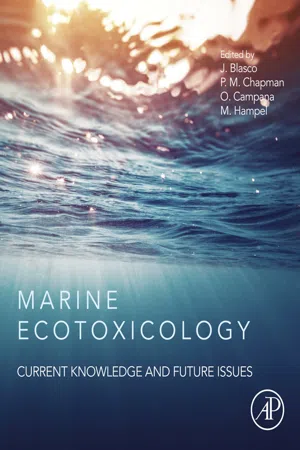
Marine Ecotoxicology
Current Knowledge and Future Issues
- 334 pages
- English
- ePUB (mobile friendly)
- Available on iOS & Android
Marine Ecotoxicology
Current Knowledge and Future Issues
About This Book
Marine Ecotoxicology: Current Knowledge and Future Issues is the first unified resource to cover issues related to contamination, responses, and testing techniques of saltwater from a toxicological perspective. With its unprecedented focus on marine environments and logical chapter progression, this book is useful to graduate students, ecotoxicologists, risk assessors, and regulators involved or interested in marine waters.
As human interaction with these environments increases, understanding of the pollutants and toxins introduced into the oceans becomes ever more critical, and this book builds a foundation of knowledge to assist scientists in studying, monitoring, and making decisions that affect both marine environments and human health.
A team of world renowned experts provide detailed analyses of the most common contaminants in marine environments and explain the design and purpose of toxicity testing methods, while exploring the future of ecotoxicology studies in relation to the world's oceans. As the threat of increasing pollution in marine environments becomes an ever more tangible reality, Marine Ecotoxicology offers insights and guidance to mitigate that threat.
- Provides practical tools and methods for assessing and monitoring the accumulation and effects of contaminants in marine environments
- Unites world renowned experts in marine ecotoxicology to deliver thorough and diverse perspectives
- Builds the foundation required for risk assessors and regulators to adequately assess and monitor the impact of pollution in marine environments
- Offers helpful insights and guidance to graduate students, ecotoxicologists, risk assessors, and regulators interested in mitigating threats to marine waters
Frequently asked questions
Information
Contaminants in the Marine Environment
Abstract
Keywords
1.1. Introduction
1.2. Sources and Properties
1.2.1. Metals
Table of contents
- Cover image
- Title page
- Table of Contents
- Copyright
- Contributors
- Preface
- Acknowledgments
- Chapter 1. Contaminants in the Marine Environment
- Chapter 2. Contemporary Methods for Statistical Design and Analysis
- Chapter 3. Dynamic Modeling for Uptake and Effects of Chemicals
- Chapter 4. Bioaccumulation and Biomonitoring
- Chapter 5. Biomarkers and Effects
- Chapter 6. Saltwater Toxicity Tests
- Chapter 7. Sediment Toxicity Testing
- Chapter 8. Mesocosm and Field Toxicity Testing in the Marine Context
- Chapter 9. Ecological Risk and Weight of Evidence Assessments
- Chapter 10. Global Change
- Index